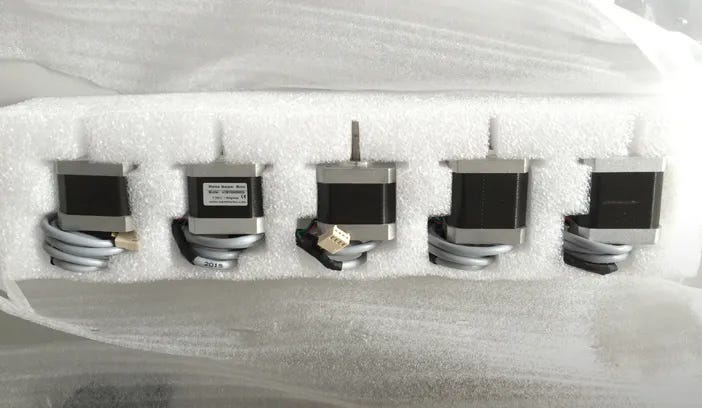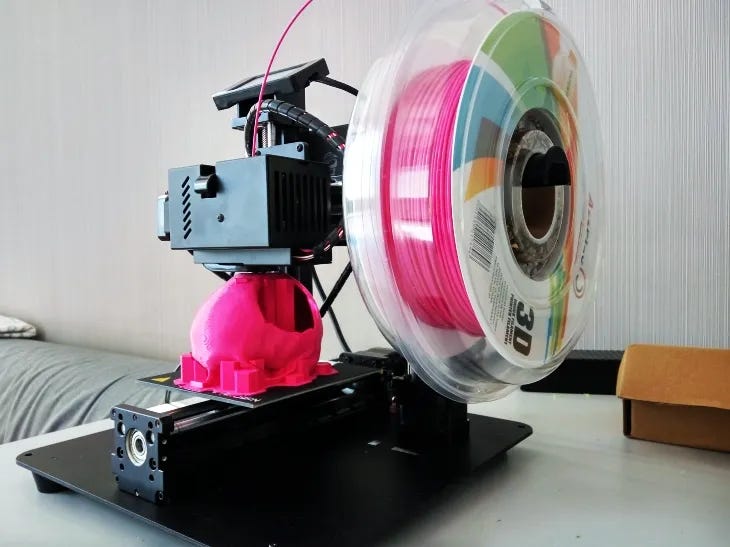What’s next for FDM / FFF 3D printers?
How much faster can you print? How much cheaper?
In one of my previous articles, I described the historical development cycle of FDM / FFF 3D printers, starting from Stratasys — through RepRap Project, and MakerBot — to the latest revolutionary innovations introduced by the rising star in the industry — Bambu Lab.
While discussing the milestones achieved by 3D printer manufacturers, I emphasized that each innovation, though exciting at the time of its introduction, was eventually overshadowed by the next one, taking the entire technological segment to a higher level.
The success of Bambu Lab is largely based on four pillars:
super-fast part production
higher quality of 3D printed parts compared to competitors
seamless remote workflow thanks to excellent cloud solutions
a genuinely low device price, considering all the aforementioned features and improvements.
Based on historical data from manufacturers like MakerBot, Zortrax, Ultimaker, Prusa, and Bambu Lab’s current success, we can conclude that to achieve “revolutionary market success,” a 3D printerneeds to be:
faster
provide better part quality
easier to use
cheaper.
The natural questions that arises at this moment are: what can be done to achieve these parameters, and what will be the next variable to improve desktop 3D printing using FDM / FFF technology and take it to an even higher level?
Two things come to my mind: one is a fairly obvious solution that will be a natural upgrade, while the other — if properly designed and implemented, will constitute a true revolution and open a completely new chapter in the history of this technology.
Servo Motors Over Stepper Motors
From a mechatronic perspective, FDM / FFF 3D printers are relatively simple, if not “primitive,” devices, especially in the amateur and lower-end desktop class. Industrial machines equipped with tightly sealed and heated work chambers, as well as sophisticated drive and 3D printing systems, are much more complex.
Amateur and desktop devices are essentially “cutting or printing plotters” to which motion in the Z-axis and a specific method of delivering thermoplastic material have been added.
The “magic” of these 3D printers lies in the software that first slices the 3D model into layers and then generates the motion of the printing head in the XYZ axes, considering a multitude of additional parameters (support structure generation, thin wall filling, etc.)
Mechanically, however, 3D printers of this type are simple. It’s no wonder that they were initially built from scratch based on relatively basic technical documentation downloaded from the internet (e.g., RepRap Project).
Since the vast majority of FDM / FFF 3D printers have relatively small working areas (20–30 cm in the XYZ axes) and the speeds they achieve have never been impressive (the limitation has always been the filament — how it’s extruded and the need for it to cool after application to prevent the layers from “bleeding” into each other), stepper motors have always been sufficient for moving these 3D printers.
Stepper motors are cheap, and their control from a software and firmware perspective is relatively simple.
However, this doesn’t change the fact that they have many obvious disadvantages compared to servo motors, which are the domain of high-performance industrial machines:
stepper motors have limited “resolution” expressed in the number of steps per rotation, while servo motors use encoders to provide much higher precision and resolution
stepper motors lose torque at higher speeds, whereas servo motors can maintain constant torque over a wide range of speeds
servo motors have built-in feedback, allowing for precise control of position and speed, while stepper motors operate without feedback, which means they can lose steps or shift position, resulting in “skipping” in printed layers
stepper motors consume energy even when not in motion because they need to maintain a constant magnetic field, while servo motors are more energy-efficient because they only consume power when necessary to maintain or change position.
Unfortunately, systems based on servo motors are much more complex in terms of design and implementation due to the need for more advanced controllers and algorithms to manage feedback and positioning.
Controlling motion with stepper motors is comparatively “straightforward.” All of this also translates into design and production costs, and in an industry where achieving the lowest price is a key factor in market success, adopting an entirely new software and firmware design logic and implementing more expensive solutions in the final device entails significant risk that most companies simply do not want to take.
Nevertheless, to further accelerate the operation of 3D printers while simultaneously increasing their 3D print quality, the transition to servo motors at the amateur or desktop level is only a matter of time.
However, this would not be a revolution but rather an interesting upgrade. Because at the end of the day, the current “Holy Grail” of FDM / FFF 3D printing is something entirely different.
Transition from Filaments to Pellet
Let’s start by considering that from a mechatronic perspective, 3D printing with plastic filaments has many advantages. Controlling the flow of filament is straightforward — the filament is either pushed “down” or retracted.
Retraction is crucial because during 3D printing, the 3D printer performs many idle movements during which unextruded material could flow out of the nozzle. To prevent this, the filament is retracted and pushed back when printing resumes (this entire process can take fractions of a second).
Another advantage is that the extrusion system (extruder) is very simple and lightweight. Depending on the type, it can be installed directly above the printhead or on the device’s housing (Bowden), making it lighter and faster to move. Its simplicity allows for any service action to be performed by a amatour, requiring no specialized tools or knowledge. It also reduces production costs, enabling the overall device price to be lowered.
Unfortunately, all the savings achieved with 3D printers are often offset by the cost of filament. Currently, a 1kg spool of good-quality popular materials like PLA, ABS, or PETG can cost between $20–30 USD/EUR. Filament is produced from granules that are appropriately modified (colorants, plasticizers) to flow well through the printing nozzle and adhase on subsequent layers.
High-quality, fast, and efficient filament production lines are expensive (cheap Chinese alternatives are simply slower). Additionally, you need to include the spool (although reusable “spools” and refills are gaining popularity lately), a foil package with moisture absorbers (filaments are hygroscopic), and a box.
Furthermore, contrary to what may seem common, producing high-quality filament is challenging and demanding. I personally know several stories of experienced plastics processing companies that thought it was an easy matter and failed spectacularly in this field. Producing high-quality filament is a true art — if you try to cut corners during production, it will always show in the 3D prints.
So, filament production is costly, and its price must be relatively high. Some time ago, Gabe Bentz from Slant 3D announced his manifesto for cheap filaments — and although I agree with the principle, in the long run, lowering prices may not be the best solution because it could lead to a decline in quality.
The solution is to completely move away from filaments in favor of raw material — pellet. The challenge is that creating a good and efficient system based on granules is neither easy nor cheap. Several 3D printing systems using granules are available on the market, but all of them are:
industrial-grade
expensive.
However, if a company were to present such a solution at the desktop 3D printer level (such as Bambu Lab P1P, UltiMaker S5, Prusa XL, etc.), it would instantly outperform all competitors. Operating costs would plummet, and in the long run, even a higher 3D printer cost would be compensated by low material costs.
3D printing from pellet — further implications
Easier written than done… Creating a pellet-based 3D printer in the desktop class is currently a big design challenge, where the key factor will be keeping the SRP price as low as possible (i.e. below ~ USD / EUR 2,000).
Honestly? I don’t even know if it’s possible? I.e. it certainly is — what I mean is more: is it possible to produce and sell such 3D printers at such prices and achieve a reasonable margin and profitability? Instead of the typical scenario for 3D printing — “we are using investors’ money, and when the scale comes, we will see”?
Well, if this could be done, the filament market will end after 2–3 years. Although the pellet used in injection molding technology will still need to be modified for 3D printing (the same granulate is not suitable 1:1 for injection and 3D printing), the market will be immediately taken over by companies that currently specialize in it. In fact, the only hope for the filament industry is that no 3D printer manufacturer manages to make this design change.
Transitioning to 3D printing with pellet will further increase the speed and throughput of 3D printing and allow for larger build volumes. It will reduce part production costs. Simultaneously, implementing servo motors will become more justified.
The question is whether anyone will take up the challenge and whether they will succeed in achieving this.
The truth is that in 2021, no one expected that Bambu Lab’s achievement was even possible. But it happened.
This article was originally published on LinkedIn on January 15, 2024. This is a reworked version.






